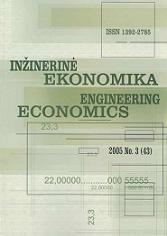Logistics Centre Concept through Evolution and Definition
Logistics Centre Concept through Evolution and Definition
Author(s): Dainora Grundey, Kristina RimienėSubject(s): Economy
Published by: Kauno Technologijos Universitetas
Keywords: logistics centre concept; definition; evolution; freight village; logistics node; distribution centre.
Summary/Abstract: Along with worldwide production and trade globalization, the importance of logistics centres is growing in the supply chain management efficiency aspect. The paper reviews existing terminology of facilities for logistics operations. Most commonly logistics centre concept is consolidated with understanding of distribution centre, central warehouse, freight/transport terminal, transport node, logistics platform, freight village, logistics depot, distripark etc. An attempt to rectify the hierarchy of logistics facilities and formulate the definition of logistics centre was made in the article. The structure of logistics facilities hierarchy was proposed by the authors. Efforts were put to compare the concepts and understandings worked out by different world and Lithuanian authors and point out the development and evolution of logistics centres. Logistics centre concept appeared 30 years ago. During this period either practical or nonfiction understanding of Logistics centre functional and conceptual significance has changed. Logistics centres can be classified into three different categories or generations on evolution basis. It is based on the scope and extension of logistics activities. Historically, typical logistics functions were shipping, receiving, storage, order picking, break-bulk, freight consolidation and containerization. Today, thanks to technology, many distribution operations are computerized, automated, and equipped with state-of-the-art material handling equipment and information systems. Nowadays many distribution operations have added a number of value-added services, including total logistics management, inventory control and tracking, packaging, labeling and bar coding, procurement and vendor management, and customer service functions, such as returns, repair, rework and assortment promotional assembly. Due to the process of evolution as well as types and functionality of centres recently developed in the market there is no embracing concept and definition for logistics centre term determination. Lots of scientists (Pegrum, 1963; Bowersox, Smykay, LaLonde, 1968; Reynaud, Gouvernal, 1987; Cavinato, 1989; Holtgen, 1996; Johnson, Wood, 1996; Wiegmans, Masurel, Nijkamp, 1998; Breitzmann, Wenske, 1999; Ballis, Golias, 2002; Židonis, 2002; Waters, 2003; Kondratowicz, 2003; Kia, Shayan, Ghotb, 2003; Ballou, 2004; Urbonas, 2004; Meidutė, Vasiliauskas, 2005; Rushton, Croucher, Baker, 2006; Lu, Yang, 2006; etc) examined the theory of logistics and supply chain management, coping with logistics centre determination and functionality analysis, among all. Survey findings showed that not only terms, but the concepts differ as well. Logistics researchers have made little effort to build a unified logistics centre conception.
Journal: Engineering Economics
- Issue Year: 2007
- Issue No: 4 (54)
- Page Range: 87-95
- Page Count: 9
- Language: English

